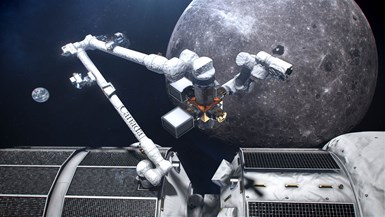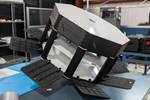Rock West Composites completes development model design for robotic arm
The Canadarm3 robotic arm will be used in the lunar Gateway Program, supplied by the Canadian Space Agency.

An artist’s concept of Canadarm3, Canada’s robotic system, located on the exterior of the Gateway, a small space station in orbit around the moon. Photo Credit: Canadian Space Agency, NASA
Rock West Composites (RWC, San Diego, Calif., U.S.) has completed the design of the development model for Canadarm3, Canada’s robotic arm for the lunar Gateway Program which is an important component of NASA’s Artemis missions. RWC is collaborating with MDA (Richmond, Canada), a developer and manufacturer in advanced technology solutions for the space industry. The team will design, analyze, manufacture and test the two primary boom structures and supporting spare units for Canadarm3.
According to the Canadian Space Agency, “Canadarm3 will be Canada’s contribution to the U.S.-led Gateway, a lunar outpost that will enable sustainable human exploration of the moon. This highly autonomous robotic system will use cutting-edge software to perform tasks around the Moon without human intervention.” MDA is tasked with establishing the technical requirements for the program, and RWC is developing the boom structures with MDA.
As a critical component of the Canadarm3 system, the boom structure is responsible for supporting the robotic arm’s operations, helping secure its stability and reliability over its 20+ year service life. The structure must meet structural and weight requirements, as well as tight dimensional tolerances, operate within wide temperature ranges and withstand radiation.
“Our collaboration with MDA builds upon our proven track record of delivering innovative solutions for the space industry,” says Jeremy Senne, head of RWC’s space market segment. “We are excited to contribute our expertise to this project, work alongside MDA to advance Canada’s space robotics capabilities, and support future deep space presence and exploration by mankind.”
Related Content
-
Composite molding compound replaces Invar for lightweight small satellite structures
Patz Materials and Technologies and Lawrence Livermore National Laboratory developed a new monolithic optics housing with 80% less weight, near-zero CTE and the high-volume manufacturing required for commercial space.
-
A new era for ceramic matrix composites
CMC is expanding, with new fiber production in Europe, faster processes and higher temperature materials enabling applications for industry, hypersonics and New Space.
-
Carbon fiber satellite arm reduces weight, simplifies assembly onto naval vessels
Satcom developer EM Solutions partnered with ACS Australia to replace an aluminum arm design with a 65% lighter, one-piece, corrosion-resistant carbon fiber/epoxy alternative.












